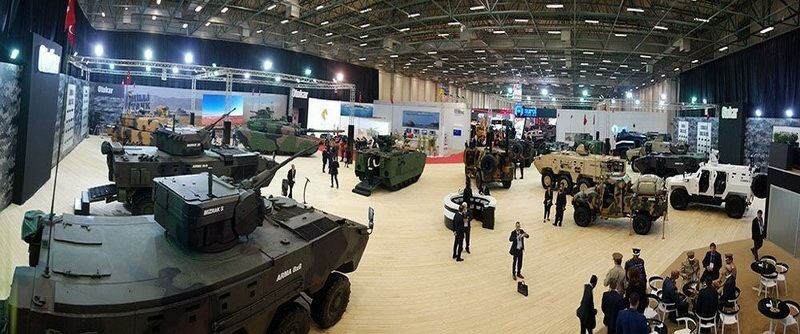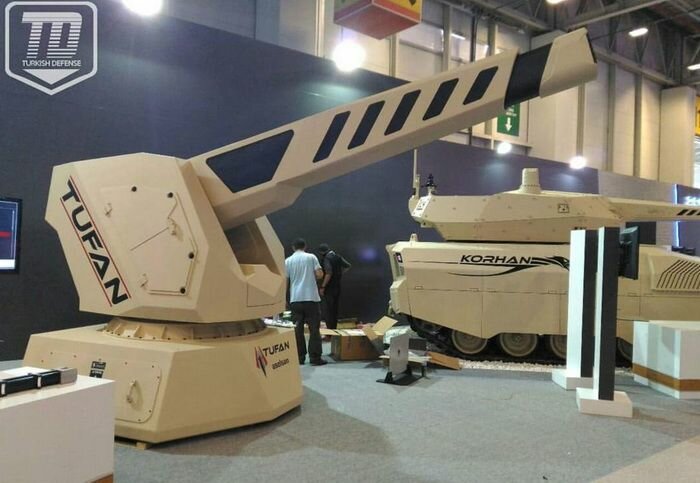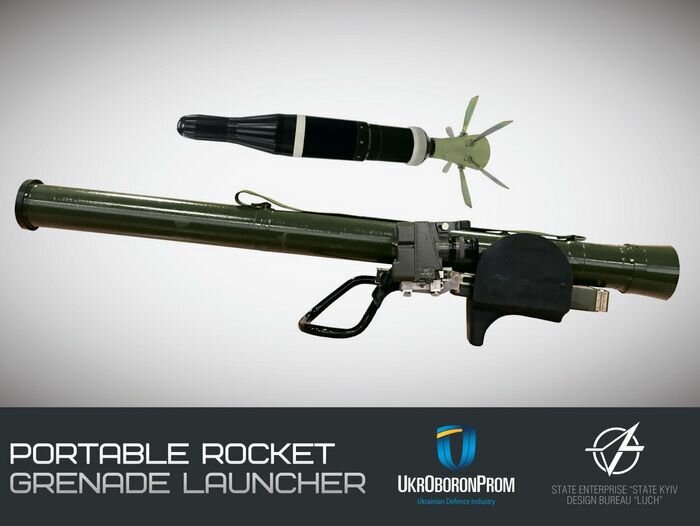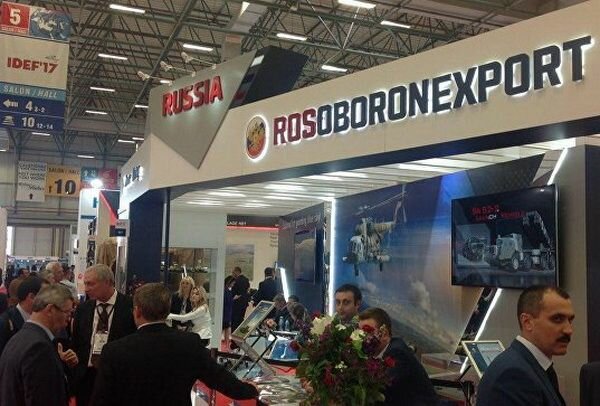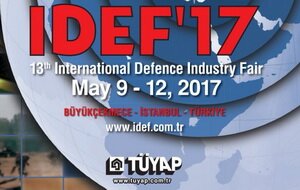
Oleksiy Volovych
The annual international exhibition of arms and military equipment IDEF-2017 (International Defense Industry Fair) is one of the five largest world exhibitions of the defense industry. The thirteenth such event was held from May 9 to May 12 at the TUYAP exhibition center, where 818 companies manufacturing weapons and military equipment (WME) and 135 international delegations from 74 countries, including Turkey, the United States, Great Britain, Italy, China, Russia and Ukraine, were represented.
Turkey's Exposition
Over the past 15 years, the Defense Industry of the Republic of Turkey (TR) has been developing rapidly, demonstrating significant successes. The leadership of Turkey has set before the domestic Defense Industry the task — by 2023 (the centenary of the Republic) to provide Turkey's Armed Forces with virtually all types of weapons and military equipment. According to Turkish Prime Minister Binali Yildirim, if in 2002, when the current ruling Justice and Development Party came to power, Turkey was meeting 80 % of its armament needs through imports, but today this figure has dropped to 40 %. That is, 60 % of such needs are covered by domestic production.
In 2017, Turkey's Defense Industry enterprises are working on the implementation of 460 projects totaling 123 billion Turkish liras (about 35 billion US dollars). The turnover of the Turkish Defense Industry is steadily increasing. Over the past 10 years, it has grown from 1 billion to 20 billion liras. While in 2002 the exports of defense products amounted to only 250 million US dollars, for the third consecutive year (since 2014) it have remained at around 1.6 billion US dollars. The task has been set to increase the volume of exports of Turkish arms and military equipment to 25 billion US dollars by 2023, which, for example, almost doubles Russia's current indicator.
The enterprises of the Turkish Defense Industry demonstrated at the Exhibition advanced developments in armored vehicles, missile armament, ship artillery systems and small arms. Besides, the Turkish Defense Industry presented three striking UAVs — ANKA, Bayraklar and Karayel-Su, armed with rockets of the Turkish company Roketsan.
The Turkish Aerospace Industries (TAI) and the British BAE Systems have signed an agreement on the joint development of a Turkish stealth fighter of a new generation called TFX. The basis for the future Turkish-British fighter is the tested single-pilot fighter F-16, operating in Turkey for more than 30 years.
|
|
The Turkish company Aselsan for the first time presented a model of an electro-magnetic gun (EMG) of a tower type called Tufan. The gun will be installed on surface ships of small displacement, in particular, on the frigate of the TF-2000 project, which Turkey plans to adopt after 2023. The energy of the shot of the prototype EMG reaches 14 mega-joules, which provides the explosive item's speed of 7242 km/h.
Aselsan also presented Korhan IFV, equipped with a turret with a 35 mm cannon and a twin machine gun of 7.62 mm caliber. The body of this IFV provides protection for the crew and landing force from shelling from machine guns of caliber 14.5 mm and even guns of caliber up to 20 mm. It is assumed that this armored vehicle will be equipped with the active protection system AKKOR, its gun — with an optic-electronic station of the ATS-30 series, providing fire control at any time of the day.
The Aselsan exhibition stand also featured a new 120 mm AHS-120 automatic mortar, both stationary and mobile-based. Of the novelties of the Turkish self-propelled artillery systems, a 155 mm Panter SAU should be noted. The chassis is the 10-ton truck produced by the national ВМС company. In the basic configuration there are 21 high-explosive fragmentation munitions. At the Aselsan's stand a new mobile compact LSS laser system was introduced for the first time. It is designed to detect and destroy small-size UAVs.
|
|
TÜBİTAK-SAGE Company presented a new modification of the SOM-J air-launched cruise missile (length 3.6 m, weight 600 kg), intended for placement on the fifth generation F-35 fighters of the Turkish Air Force. The new missile has a turbojet engine Microturbo TRI-40 manufactured by the Turkish company Kale Aero. This engine is already used in Norwegian anti-ship missiles such as NSM and French anti-aircraft guided missiles Exocet MM40.
STM presented a model of the anti-air warfare frigate TF4500 with the following parameters: length — 150.3 m; width — 16.5 m; draft — 4.5 m; full displacement — 4,500 tons; maximum speed — 32 knots; economic speed — 18 knots; the cruising range at economic speed — 7000 miles; the crew — 140 people; autonomy of the voyage — 30 days. The prospective ship will have a 76 mm cannon, two 25 mm anti-aircraft guns, two rotary launchers of anti-aircraft guided missiles of RAM type, 32 vertical launchers for surface-to-surface missiles and 16 inclined anti-ship missiles.
Ukraine's Exposition
Secretary of the National Security and Defense Council of Ukraine (NSDC) Oleksandr Turchynov took part in the official opening and the work of the IDEF-2017 International Defense Industry Exhibition in Istanbul (May 9–12, 2017). According to him, at the IDEF-2017, Ukraine demonstrated the largest exposition of weapons and military equipment for all the years of our independence. At the Exhibition, Ukraine was represented by 15 enterprises and five companies-exporters of “Ukroboronprom”, in particular, the leading Ukrainian companies-developers and manufacturers of weapons: State Kyiv Design Bureau “Luch”, “Antonov” Company, State Kyiv Design Bureau “Artillery Armament”, Basic Center of Critical Technologies “Mikrotec” and some others, whose latest samples of armored vehicles, ammunition, small arms, means of active and dynamic protection of armor, new developments in aircraft and missile construction filled the exhibition stands.
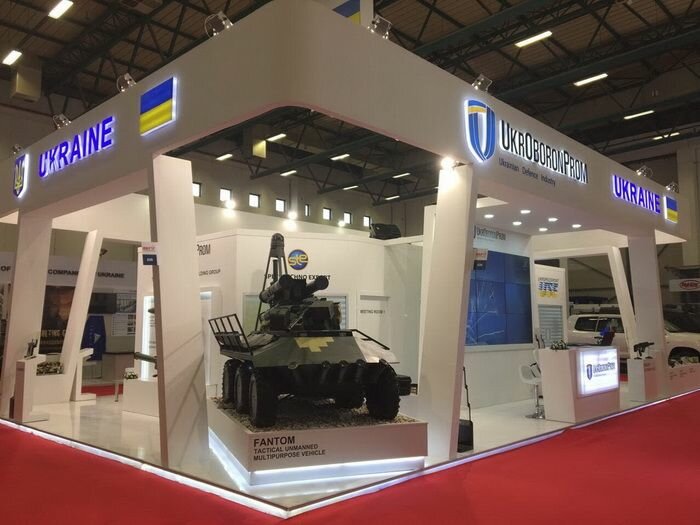
|
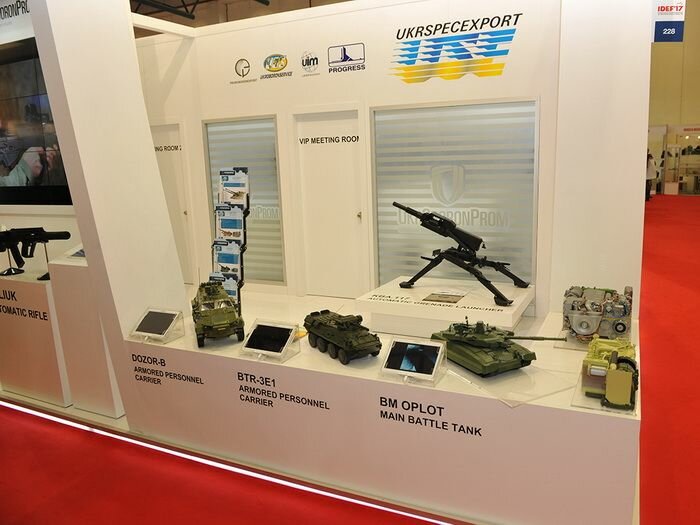
|
| Ukraine's Exposition | |
|
|
In particular, the State Concern “Ukroboronprom” presented armored personnel carriers BTR-3E1 and “Dozor-B”, main battle tank “Oplot”, missile munitions, artillery armament, firearms, etc. At the exhibition, a sample of a new Ukrainian remote controlled robotic complex (unmanned mini-armored personnel carrier) UGV “Phantom” equipped with the anti-tank missile system “Barrier” was demonstrated, which finds and destroys targets, makes reconnaissance and evacuates wounded soldiers.
State Kyiv Design Bureau “Luch” presented a portable rocket grenade launcher designed to destroy lightly-armored and unarmored equipment, field-type constructions, as well as personnel located in the outdoors and in shelters. Firing range of the portable rocket grenade launcher ranges from 70 m to almost 2 km, battle sight shot reaches 600 m. The new opto-electronic sight automates and simplifies shooter’s mission, ensuring high accuracy strike at maximum firing range.
Ukraine-Turkey Military-Technical Cooperation
|
|
In late April 2017, Secretary of the National Security and Defense Council of Ukraine Oleksandr Turchynov once again met with the head of the Defense Industry of Turkey Ismail Demir to discuss the prospects for the development of bilateral military-technical cooperation. Within the framework of participation in IDEF-2017, O. Turchynov met with Ismail Demir and the Minister of National Defense of Turkey Fikri Ishik, as well as with the management of the leading Turkish companies in the military industry Aselsan, Roketsan, Havelsan, TAI, BM, MKEK, Otokar. During these meetings, issues related to the implementation of joint tasks for the design and production of new weapons and military equipment were discussed. O. Turchynov said that a joint working group was being established to coordinate strategic projects in the sphere of development of the Defense Industries of Ukraine and Turkey. Following the talks between O. Turchynov and Minister of National Defense of TR Fikri Ishik, General Director of SC “Ukroboronprom” Roman Romanov and the head of the Defense Industry of Turkey Ismail Demir signed a memorandum on cooperation between the Defence Industries of both countries on the production of military products.
The Ukrainian-Turkish cooperation has been developing successfully in the implementation of joint programs on armored engineering. In March 2017, a memorandum on the supply of Ukrainian engines 6TD3 for the Turkish main battle tank of the third generation “Altay” was signed, the mass production of which should begin in 2017. This project is being implemented with the technical assistance of the South Korean company Hyundai Rotem. Turkey plans to produce about one thousand such tanks.
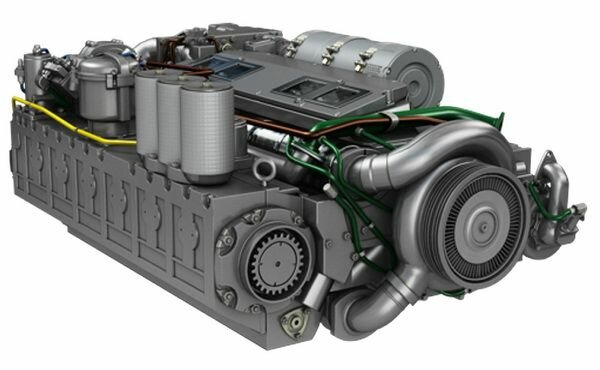
|

|
| Ukrainian engines 6TD3 for the Turkish tank Altay | |
Representatives of the State Company “Antonov” signed a memorandum of cooperation with the Turkish Aerospace Industries (TAI) in the development and production of various modifications of unmanned aerial vehicles for the needs of the Armed Forces of Ukraine. Also, the SC “Antonov” in cooperation with the companies TAQNIA (Saudi Arabia) and Havelsan (Turkey) will develop a new modification of the An-132 Maritime Patrol Aircraft. The parties signed the relevant memorandum on 10 May at the IDEF-2017. An-132 is the first Ukrainian aircraft, created by the “Antonov” Company without the use of Russian component parts. The first demonstration flight of the An-132D aircraft successfully passed on March 31, 2017. The aircraft was designed as a “Western” version of the An-32 transport aircraft with a part of the components of foreign manufacturers: engines from Pratt&Whitney (Canada), avionics from Honeywell (USA), life support systems from German Liebherr, propellers from Messier Bugatti Dowty (France) and auxiliary power-generating sets from Hamilton Sundstrand (USA).
At the IDEF-2017, Turkey's leading defense company “Aselsan” and the “Antonov” Company signed a cooperation memorandum to equip the An-148 series of passenger aircraft with a set of radio electronic equipment. The parties also agreed on cooperation in equipping the An-158 and An-178 short-range military transport aircraft with special equipment and on combining efforts in the promotion of these aircraft in the world market.
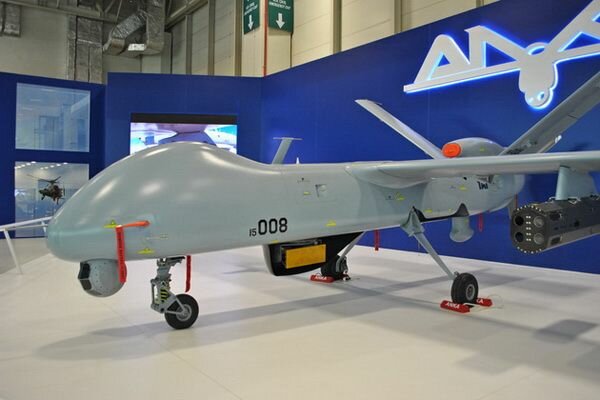
|

|
| Turkish Aerospace Industries' ANKA UAV and Ukrainian An-132 by the SC “Antonov” | |
Representatives of the Ukrainian and Turkish Defense Industries reached an agreement on the implementation of the joint production of heavy aircraft drones, direction finding equipment and passive radiolocation. By 2020–2021, this project can reach the level of serial production. Turkish drones ANKA, Bayraktar and Karayel-Su are able to stay in the air for a day, operate at a distance of up to 200 kilometers from the operator and carry up to 200 kilograms of payload.
The parties also agreed on the joint production of a wide range of ammunition at one of the Ukrainian special-chemical plants. The Turkish company MKEK became a partner in the production of ammunition. About 800 Ukrainian enterprises of various profiles can be involved in this process. In the near future, the SC “Ukroboronprom” plans to open a representative office in the Turkish Republic, which will contribute to further development of military-technical cooperation between the two countries.
The significant success achieved by the Ukrainian Defense Industry at IDEF-2017 in Istanbul is logical. The independent Ukraine's military-technical cooperation with the Republic of Turkey has a long history and a solid contractual and legal basis. The first documents in the field of military-technical cooperation between the two countries were signed back in the early 1990s. The current activation of the Ukrainian-Turkish military cooperation contributes to a climate of confidence and security in bilateral relations and in the Black Sea region, which is in line with Ukraine's course to Euro-Atlantic integration. Kyiv and Ankara are interested in deepening bilateral military cooperation, considering it one of the basic principles of security and military-political stability in the Black Sea region.
It should be noted that, during the IDEF-2017 Exhibition in Istanbul, Ukrainian, Israeli and Turkish media debated the issue of the possible choice of the Ministry of Defense of Ukraine between Israeli and Turkish suppliers of VHF communications for the Armed Forces of Ukraine. In fact, last year the Defense Ministry of Ukraine already made a choice between the products of Israeli and Turkish suppliers in favor of the Turkish company Aselsan, as the conditions of the competing Israeli company Elbit Systems were less favorable for a number of parameters. Nevertheless, the Israeli and Ukrainian lobbyists of Elbit Systems continue to insist on the cancellation of the agreement with the Turkish company and carrying out repeated tests of the products of the mentioned companies. In this situation, in our opinion, one should listen to the opinion of the Director of the Center for Army Studies, Conversion and Disarmament Valentin Badrak, who believes that “shuffling from one partner to another can lead to the cancellation of the planned project, on the basis of which the state's defense depends. Breaking the project with Aselsan would also be a serious blow to Ukraine's reputation in the market”. I think it would be reckless for the Ministry of Defense of Ukraine to break the contract with the Turkish company Aselsan, since this could negatively affect the whole package of agreements on military technical cooperation between Ukraine and Turkey, and instead of the “Ukrainian breakthrough” there could be a “Ukrainian breakdown” or failure. But in this case, no doubt, Solomon's solution should be sought — reaching a compromise with Elbit Systems, since the loss of cooperation with this well-known company in the world would also be very undesirable for the entire Ukrainian-Israeli MTC.
The Failures of the Russian Defense Industry in Istanbul
According to the SIPRI (Stockholm International Peace Research Institute), since 1992 the Russian Federation has supplied 174 armored personnel carriers BTR-80, 23 — BTR-60PB and 19 Mi-17 helicopters to Turkey. After this, there have been practically no large-scale deliveries of Russian arms and military equipment to Turkey. At the IDEF-2017 Russia was represented by “Rosoboronexport” and the “Almaz-Antey” Air and Space Defense Concern. The Russian delegation at the exhibition was headed by Deputy Director of the Federal Service for Military-Technical Cooperation M. Petukhov. All in all, at the IDEF-2017 exhibition, Russian corporations Rosoboronexport and Almaz-Antey presented about 200 models of weapons and military equipment, which is exactly half as many as at IDEF-2015.
Over the past few years, Moscow and Ankara have been negotiating on the supply of S-400 “Triumph” SAM to Turkey. According to some sources, Russia is ready to supply these complexes at a price of 500 million US dollars for a division. However, according to some Russian military experts, Turkey is unlikely to seriously intend to buy Russian SAMs. In its rather complicated relations with the USA and NATO, Ankara simply demonstrated its “independence”. However, after Erdogan's visit to Washington on 16 May 2017, in the course of which he voiced assurances about the strengthening of strategic relations with the USA and NATO, there is no need for such a demonstration. Moreover, Turkey has alternative options — the opportunity to purchase the Patriot missile system from the American company Lockheed Martin/Raytheon and the SAMP/T system from the European consortium Eurosam.
According to Russian experts, the greatest interest of Turkish customers in the Russian exposition was caused by the SAM S-400 “Triumph”, SAM “Tor-M2KM”, the “Pantsir-S1” (Tunguska-3) anti-aircraft missile and gun system of land and sea basing, as well as portable SAM “Igla-S”. Experts of Rosoboronexport consider the protection of armored vehicles the most perspective for the land forces of the Armed Forces of Turkey and other countries of Asia and Africa: the Arena-E active defense complex, the Cornet-E anti-tank missile system, and the Kalashnikov assault rifles of various modifications.
However, Russia failed to reach a single agreement on the above-mentioned WME with representatives of the Turkish defense industry on the sale or cooperation in joint production. There is nothing strange about this. Firstly, in the conditions of international sanctions for the last three years, Russian enterprises cannot receive imported spare parts and components for the production of new WME models. Secondly, representatives of the Russian Defense Industry, as a rule, tend to only supply finished products in small quantities and do not agree to joint production with the transfer of at least part of technologies to Turkey. Thirdly, despite the rather frequent meetings of R. Erdogan and V. Putin, the current relations between Turkey and Russia can hardly be called trustful and truly friendly for many reasons. Therefore, Ankara sees Russia not as an ally, but rather as a competitor and even a potential adversary in the Middle East and the Black Sea region. But then, the Kremlin thinks the same about Turkey... Fourthly, despite Turkey's sometimes rather “free conduct” in NATO, the Turkish leadership still cannot neglect its allied relations in the Alliance and decide on a large-scale military-political and even military-technical cooperation with Russia. And, fifthly, unlike Russia, where the Defense Industry is still functioning within the framework of the Soviet format with its excessive centralization and state bureaucracy, Ukraine and Turkey are moving to a modern format of interaction between the public and private sectors, which allows their Defense Industries to be more flexible, operative and competitive.
* * *
Ukraine's successful participation in the 13th Istanbul Exhibition of arms and military equipment IDEF-2017 is a consequence of the planned activity of the Ukrainian leadership aimed at struggling for the Turkish arms and military equipment market. President P. Poroshenko, Prime Minister V. Groysman, NSDCU Secretary O. Turchynov, Chairman of the Verkhovna Rada A. Parubiy and other responsible representatives of various state structures during the last three years have held a series of important meetings with representatives of the Turkish leadership of different levels, in the course of which in general managed to convince the Turkish partners that cooperation between Ukraine and Turkey in various fields is mutually beneficial and promising.
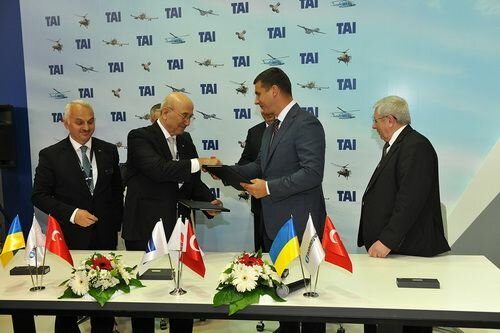
|
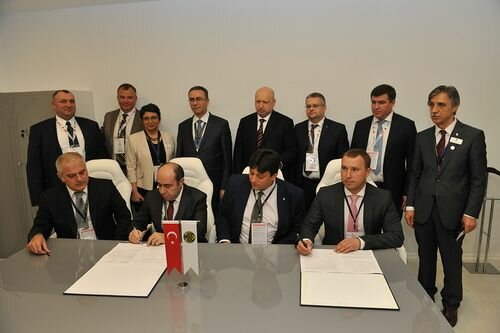
|

|
| Ukraine's successful participation in the 13th Istanbul Exhibition of arms and military equipment IDEF-2017 | ||
As for the Defense Industry, our Turkish partners seem to have understood that Ukraine actually has all the technologies of the military industry that Russia has, and at this Ukraine does not put forward any political demands and conditions. On the other hand, relations between Russia and the TR can now be qualified as a “hybrid friendship”, when both sides declare one things, but in fact act quite differently, since they are guided exclusively by their opportunistic and bloc interests. This format of relations between Moscow and Ankara is largely determined by both regional and geopolitical rivalry, despite the significant economic cooperation between them.
The development of mutually beneficial cooperation between Ukraine and Turkey in the sphere of Defense Industry is clearly not up to the Kremlin strategists' liking, and they qualify it only as “another blow in the back of Russia from Turkey”. However, the Kremlin's information warfare to discredit Ukraine, both in Turkey itself and in the international arena, using a variety of fake “news” and campaigns, demonstrates its complete failure.
To Ukraine, extensive cooperation with Turkey, in the situation of the ongoing three-year confrontation with Russia, is of great political importance, since it shows that Turkey, like all other neighboring countries, does not follow the Kremlin's aggressive anti-Ukrainian policy and thus stresses Moscow's international isolation.


